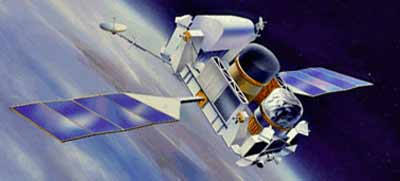Thank you very much for visiting Gunter's Space Page. I hope that this site is useful and informative for you.
If you appreciate the information provided on this site, please consider supporting my work by making a simple and secure donation via PayPal. Please help to run the website and keep everything free of charge. Thank you very much.
CGRO (GRO, Compton)

CGRO [NASA]
The Compton Gamma-Ray Observatory (CGRO) is one of NASA's four "Great Observatories". GRO's specific mission is to study the sources and astrophysical processes (e.g., nuclear reactions, electron bremsstrahlung, matter-antimatter annihilation, elementary particle producation and decay, Compton scattering, and synchrotron radiation) that produce that highest energy electromagnetic radiation from the cosmos. GRO carries a complement of four instruments that provide simultaneous observations covering over five decades of energy from 0.1 MeV to 30 GeV:
- OSSE (Oriented Scintillation Spectrometer Experiment) by Naval Research Laboratory detects gamma rays entering the field of view of any of four detectors in the 100 keV.to 10 MeV range.
- Imaging Compton Telescope (ICT) by Max Planck Institute is tuned to the 1-30 MeV energy range and determines the angle of arrival within a degree and the energy of photons to within five percent at higher energies.
- Energetic Gamma Ray Experiment Telescope (EGRET) measures high energy (20 MeV to 30 GeV) gamma ray source positions to a fraction of a degree and photon energy to within 15 percent. EGRET is developed by NASA GSFC, Max Planck Institute, and Stanford University.
- Burst and Transient Source Experiment (BATSE) by NASA MSFC scours the sky to short duration gamma ray bursts (20 to 600 keV. and conducts full sky surveys for long lived sources It consists of 8 detectors.
The initial phase of the science program consists of a near-uniform survey of the complete celestial sky followed by specific concentrations in later phases; a 6 to 10-year mission lifetime is anticipated. The GRO spacecraft is a 3-axis stabilized, free-flying spacecraft that is capable of pointing at any celestial target for a period of 14 days or more with an accuracy of 0.5 degree. Attitude determination accuracy is 2 arc minutes. If a significant celestial event should occur at some other location, GRO is capable of maneuvering to any orientation, by ground command, within 36 hours. Absolute timing is accurate to 0.1 ms. The observatory has an onboard propulsion system, with approximately 1860 kg of monopropellant hydrazine, for orbit maintenance. CGRO was deorbited in a controlled reentry, into a defined area of the Pacific Ocean at mission demise.
| Nation: | USA |
|---|---|
| Type / Application: | Astronomy, Gamma rays |
| Operator: | NASA |
| Contractors: | TRW (spacecraft) |
| Equipment: | OSSE, ICT, EGRET, 8 BATSE detectors |
| Configuration: | |
| Propulsion: | Hydrazine propulsion system (1900 kg fuel) with 4 100-lbf thrusters and 8 5-lbf ACS thrusters |
| Power: | 2 deployable solar arrays, batteries |
| Lifetime: | 6-10 years |
| Mass: | 15620 kg |
| Orbit: | 448 km × 453 km, 28.5° |
| Satellite | COSPAR | Date | LS | Launch Vehicle | Remarks | |
|---|---|---|---|---|---|---|
| CGRO (GRO, Compton) | 1991-027B | 05.04.1991 | CCK LC-39B | Shuttle | with Atlantis F8 (STS 37) |
References:
- NSSDC Master Catalog: Compton Gamma-Ray Observatory
